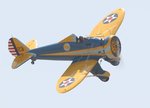- Thread starter
- #21
Oreo
Senior Airman
Well, the only book I seem to have on hand with the D.21 seems to indicate 286 mph at 16,732 ft for the Mercury 8 version, and a service ceiling of 36,000 ft, which is higher than pilots could normally go without getting the bends. Most impressive, that, and yet it must be remembered that most P-39's had service ceiling of 34-37,000 feet, and yet we've been told their flight characteristics were no good over 16,000 ft, so service ceiling is not really a super good indication of capabilities.



